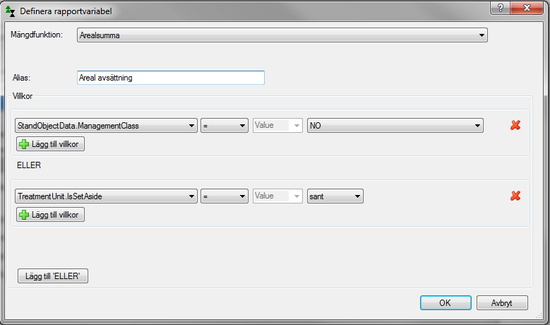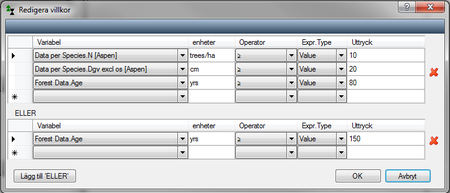Difference between revisions of "Version 2.1.0"
| Line 91: | Line 91: | ||
==Less risk for choosing "wrong" calculation model for regeneration== | ==Less risk for choosing "wrong" calculation model for regeneration== | ||
| − | Now and then some users have accidently selected Regeneration Model = "Database" instead of "Simulation". "Database" means that a | + | Now and then some users have accidently selected Regeneration Model = "Database" instead of "Simulation". "Database" means that a tree plot is selected from the Hugin young stand inventory database to represent the new tree population, and that a random factor determines what kind of regeneration is obtained. The option "Database" is mainly available as an option to be able to compare RegWise with its predecessor Hugin. From version 2.1, you must actively set a new parameter called "Allow Database Regeneration Model" to true in control table Treatment Model to be able to select this option. If set to false (which is default), the alternative will not be selectable. |
<feedDate>2014-06-15</feedDate> | <feedDate>2014-06-15</feedDate> | ||
<endFeed /> | <endFeed /> | ||
Revision as of 11:23, 10 June 2014
Sammanfattning
- Version 2.1 contains several new functions:
- Simulation results can now also be saved in StandWise.
- Storm windthrows can be simulated in RegWise.
- Estimation of root rot occurrence can be calculated.
- The county code (the so called "Dlänskod" as defined by NFI) is calculated autmatically when you import a stand register that contains coordinates. This means that Definition:CountyCode is not mandatory if you have entered coordinates in the stand register for each stand. If you have entered a county code, that county code will be used.
Treatment areas in RegVis
- The models for allocating regeneration, cleaning and thinning activities to stands have been modified so that the obtained areas and volumes vary less between different simulations, and are closer to the calculated or entered target levels.
Save simulation result in StandWise
You can now connect a result database in StandWise and save a simulation. If you open a saved simulation the program will restore the management program based on the treatment codes. Choosing a result database in StandWise is optional.
Modified handling of tree species in thinning configuration
You can now include more than one species group in a thinning group. You do this in control table Treatment Model under Thinning Configuration, and the feature is available when Thinning Model is set to "LOEriksson" or "Hugin". The option "HuginOld" works as before. In previous versions, each species group have been assigned its own thinning specification. In addition, all species groups that you have not defined a thinning specification for, are placed in the same group. The new feature leads to that the choice of thinned trees is more is more determined by tree size than tree species.
Moified handling of tree species in cleaning specification
In the same ways as for thinning (see above) serveral species group can be included in the same cleaning group. You do this in control table Treatment Model under Cleaning Configuration.
Calculation of expected occurence of root rot in Norway spruce
A model for calucating root rot occurence in Norway spruce has been implemented (Thor et al. 2005, see below). The result variables are located in the result group Mortality Data. The result variables are the expected number of infected trees ("Root Rot Stems"), and basal area ("Rot Root Potential Basal Area") and volume ("Rot Root Potential Volume") for these trees. The basal area and volume refer to the whoel trees, not only the infected parts. Currently, timber value losses due to root rot are not calculated.
Model: Thor, M., Ståhl, G. & Stenlid, J., 2005
Inläggning av egna bilder i PlanEval
You can now link your own images to an alternative in PlanEval. Note that PlanEval can be used independently from other Heureka applications ochand that an MCDA problem analysed does not even have to a forestry problem.
OR-conditions in reports
You can now used OR-type conditions in reports. An example is if you would like to sum the area of partial set asides ("generell hänsyn") with full set asides (stands put in forest domains that are unmanaged). In previous version, you had to create two different reports for these.
Read more in Heurekas hjälpdokumentation
Or-conditions in forest domains
A new feature is the possibility to use "Or"-conditions when defining forest domain.
Read more in Heureka Helpdoc (Swedish only).
Specific form for breeding effect in StandWise
When you simulate a regeneration in StandWise and choose to plant with breeded plants, you can enter all settings needed in a form specifically designed for StandWise. IN previous version, you had to use the same form as was designed for PlanWise and RegWise (via control table Treatment Model > Breeding Effect).
Less risk for choosing "wrong" calculation model for regeneration
Now and then some users have accidently selected Regeneration Model = "Database" instead of "Simulation". "Database" means that a tree plot is selected from the Hugin young stand inventory database to represent the new tree population, and that a random factor determines what kind of regeneration is obtained. The option "Database" is mainly available as an option to be able to compare RegWise with its predecessor Hugin. From version 2.1, you must actively set a new parameter called "Allow Database Regeneration Model" to true in control table Treatment Model to be able to select this option. If set to false (which is default), the alternative will not be selectable.
Buggfix: Snabbare nuvärdesberäkning i BeståndsVis
Nuvärdesberäkningen i BeståndsVis går nu mycket snabbare än tidigare. Felet var att fler slutavverkningsperioder än vad som angetts i kontrolltabellen Treatment Program Generator testades. Felet gäller bara BeståndsVis.
xxx

